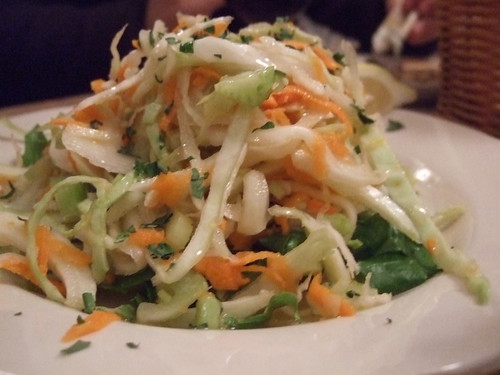Thanksgiving Redux: How one meal was reinvented into six different incarnations (click to enlarge)
We always have a ton of vegetables at our table so soups, pot pie, shepherd's pie, etc. are a natural progression from the Thanksgiving meal. Because I cut the backbone out of my turkey I had the back plus the neck to make turkey stock for the gravy. There was so much stock, however, that Mom didn't use it all for the gravy, and I didn't even have to use any turkey bones to make the vegetable soup the next day. In fact it's Sunday now, and I've just cleaned the carcass enough to make stock that I will freeze in ice cube trays for future use in soups and sauces that call for chicken stock.
From the diagram it's clear that the turkey pot pie was the catch all for the most ingredients and that the turkey itself was used in the most dishes. No surprise there at all. For some reason, it didn't occur to me to put any cut up turkey into the vegetable soup, probably my body telling me to keep things as light as possible the day after the big day. I have to say though that as the primary cook, I had no time for breakfast as I was so busy from the moment I got up, so calorie wise I probably ate less on Thanksgiving than usual, even with pie and ice cream for dessert. Certainly I was nibbling and tasting in the kitchen, but my other T-Day strategy was to fill my plate with vegetables on the first go round and then go back for turkey and stuffing and gravy. Then we always take a walk after dinner and before dessert.
Missing from the menu side of the list are steamed broccoli (my aunt's must have vegetable), apple pie, and black pepper ice cream. I gave my sister the vegan all of the broccoli to take home, but I wish I'd made it into a pureed soup of broccoli and potatoes. That would have been so easy to have simply made in the blender and would have used the potato gratin that had been made with cream and spread the calories into a healthy soup.
My other imperative post Thanksgiving is to eat down the fridge as much as possible. Leading up to the big day my fridge was packed with ingredients, then with leftovers. I'm loathe to throw food away so even the meatballs my aunt insisted on making will probably be made into minestra mariata. My freezer was quite packed to begin with, so some of the dishes, like the gumbo used a quart of creole sauce I'd made and frozen at summer's end, and the chilaquiles will be made from frozen homemade tortillas that didn't turn out so successfully. I'm also going to use some fresh black beans that have been waiting patiently to be cooked. The gumbo and chilaquiles are a good reminder that the leftover reincarnation should be something so dissimilar from the original dishes that the meal in no way feels like leftovers at all.
I've blogged on other occasions about chilaquiles and gumbo, so today I'll give the breakdown on my pot pie. It works on many levels, one of which was preparing it in the same casserole dish that I'd used for the potato gratin, meaning I didn't even have to wash nor dirty another baking dish! I'd also used frozen pie pastry from earlier in the year with the chocolate pecan pie. There was a smidge leftover that was just right for topping the pot pie. Since this dish is made of leftovers and who knows what you may have on hand, the instructions are more about the assembly and don't really contain precise measurements for some ingredients. Everything is already cooked basically, so just taste your combination and adjust the seasonings as necessary.
Turkey Pot Pie
Preheat the oven to 375 degrees. In a large mixing bowl combine
leftover veggies from Thanksgiving,
cut into similarly sized pieces if necessary (i.e. green beans should be cut to about an inch to fit on a fork. Large pieces of squash or fennel should also be fork sized. I used carrots, brussel sprouts, radishes, turnips, sweet potatoes, fennel, green beans, mushrooms, scalloped potatoes, etc.)
a cup or two of cubed leftover turkey and
enough leftover gravy to moisten the mixture
(you may have to heat the gravy to loosen it enough to mix with the veggies). Season to taste with
salt and pepper and
a couple tablespoons of chopped fresh herbs such as parsley, thyme, sage, etc (optional)
Pour the mixture into an appropriately sized casserole or baking dish so that the veggies almost reach the top rim. Roll out a
portion of pie dough*
to cover the casserole. The rolled out dough needn't completely cover the vegetable contents. Bake your casserole in the oven for 45 minutes, checking at 30 minutes and rotating to ensure even browning. When the gravy is bubbling and the top is nicely browned (whether using pie crust or mashed potatoes), your pie is ready. Let cool slightly for maybe 10 minutes then dig in!
In lieu of the pie dough you could also make a shepherd's pie using leftover mashed potatoes. Warm slightly in the microwave to loosen the potatoes then top the vegetable and turkey mixture with a spread of mashers and dot with small pieces of butter.










